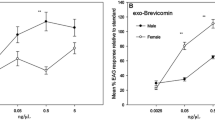Abstract
Frontalin andexo-brevicomin were identified by GC-MS in air drawn over maleDendroclonus ponderosae Hopk. (MPB) from Oregon that had joined females for 1–2 days in the bark of lodgepole and ponderosa pine logs. Unfed males releasedexo- andendo-brevicomin but not frontalin. These three compounds were not detected in either unfed or fed females. Arrestment of males bytrans-verbenol and terpenes in an olfactory walkway was reduced by the addition of racemic frontalin; production of attractant chirps also diminished. Racemic frontalin also strongly reduced the aggregation of MPB in lodgepole and ponderosa pine stands to sticky traps baited with the aggregation pheromonetrans-verbenol and host terpenes; however, the function of the natural enantiomer of frontalin in MPB is unknown.
Similar content being viewed by others
References
Bedard, W.D., Tilden, P.E., Wood, D.L., Silverstein, R.M., Brownlee, R.G., andRodin, J.O. 1969. Western pine beetle: Field response to its sex pheromone and a synergistic host terpene, myrcene.Science 164:1284–1285.
Bedard, W.D., Silverstein, R.M., andWood, D.L. 1970. Bark beetle pheromones.Science 167:1638–1639.
Bedard, W.D., Wood, D.L., Tilden, P.E., Lindahl, K.Q., Silverstein, R.M., andRodin, J.O. 1980a. Field response of the western pine beetle and one of its predators to host- and beetle-produced compounds.J. Chem, Ecol. 6:625–641.
Bedard, W.D., Tilden, P.E., Lindahl, K.Q., Jr., Wood, D.L., andRauch, P.A. 1980b. Effects of verbenone andtrans-verbenol on the response ofDendroctonus brevicomis to natural and synthetic attractant in the field.J. Chem. Ecol. 6:997–1013.
Billings, R.F., Gara, R.I. andHrutfiord, B.F. 1976. Influence of ponderosa pine resin volatiles on the response ofDendroctonusponderosae to synthetictrans-verbenol.Environ. Emomol. 5(1):171–179.
Borden, J.H., Vandersar, T.J., andStokkink, E. 1975. Secondary Attraction in the Scolytidae: An Annotated Bibliography. Pestology Centre, Simon Fraser University, Burnaby, B.C., 97pp.
Furniss, M.M., andSchmitz, R.F. 1971. Comparative attraction of Douglas-fir beetles to frontalinand tree volatiles. USDA For. Serv. Res. Pap. INT—96, 16 pp.
Furniss, M.M., Kline, L.N., Schmitz, R.F., andRudinsky, J.A. 1972. Tests of three pheromones to induce or disrupt aggregation of Douglas-fir beetles in live trees.Ann. Emomol. Soc. Am. 65:1227–1232.
Jantz, O.K., andRudinsky, J.A. 1965. Laboratory and field methods for assaying olfactory responses of the Douglas-fir beetle,Dendroctonus pseudotsugae Hopkins.Can. Entomol. 97:935–941.
Kinzer, G.W., Fentiman, A.F., Jr., Page, T.F., Jr., Foltz, R.F., Vité, J.P., andPitman, G.B. 1969. Bark beetle attractants: Identification, synthesis and field bioassay of a new compound isolated fromDendroctonus.Nature 221:447–448.
McKnight, R.C. 1979. Differences in response among populations ofDendroctonus ponderosae to its pherornone complex. MS thesis, University of Washington, Seattle, 77 pp.
Michael, R.R., andRudinsky, J.A. 1972. Sound production in Scolytidae: specificity in maleDendroctonus beetles.J Insect Physiol. 18:2189–2201.
Payne, T.L., Coster, J.E., Richerson, J.V., Edson, L.J., andHart, E.R. 1978. Field response of the southern pine beetle to behavioral chemicals.Environ. Entomol. 7:578–582.
Pitman, G.B. 1971.trans-Verbenol andalpha-pinene: Their utility in manipulation of the mountain pine beetle.J. Econ. Entomol. 64(2):426–430.
Pitman, G.B., andVité, J.P. 1969. Aggregation behavior ofDendroctonus ponderosae in response to chemical messengers.Can. Entomol 101:143–149.
Pitman, G.B., andVité, J.P. 1970. Field response ofDendroctonus pseudotsugae (Coleoptera: Scolytidae) to synthetic frontalin.Ann. Entomol. Soc. Am. 63:661–664.
Pitman, G.B., Vité, J.P., Kinzer, G.W., andFentiman, A.F., Jr., 1968. Bark beetle attractants:trans-Verbenol fromDendroctonus.Nature 218:168–169.
Pitman, G.B., Vité, J.P., Kinzer, G.W., andFentiman, A.F., Jr., 1969. Specificity of population-aggregating pheromones inDendroctonus.J. Insect Physiol. 15:363–366.
Pitman, G.B., Stock, M.W., andMcKnight, R.C. 1978. Pheromone application in mountain pine beetle/lodgepole pine management: Theory and practice, pp. 165–173,in Theory and Practice of Mountain Pine Beetle Management in Lodgepole Pine Forests. Forest, Wildlife and Range Exp. Sta., University of Idaho, Moscow, Idaho 83843, 224 pp.
Renwick, J.A.A., andVité, J.R. 1969. Bark beetle attractants: mechanism of colonization byDendroctonus frontalis.Nature 224:1222–1223.
Rudinsky, J.A., andRyker, L.C. 1976. Sound production in Scolytidae: Rivalry and premating stridulation of male Douglas-fir beetle.J. Insect Physiol. 22:997–1003.
Rudinsky, J.A., andRyker, L.C. 1977. Olfactory and auditory signals mediating behavioral patterns of bark beetles, pp. 195–209,in V. Labeyrie (ed.). Comportment des Insectes et Milieu Trophique. No. 265, Colloques Internationaux de Centre National de la Recherche Scientifique, Paris.
Rudinsky, J.A., andRyker, L.C. 1980. Multifunctionality of Douglas-fir beetle pheromone 3,2-MCH confirmed with solvent dibutyl phthalate.J. Chem. Ecol. 6:193–201.
Rudinsky, J.A., Furniss, M.M., Kline, L.N., andSchmitz, R.F. 1972. Attraction and repression ofDendroctonus pseudotsugae (Coleoptera: Scolytidae) by three synthetic pheromones in traps in Oregon and Idaho.Can. Entomol. 104:815–822.
Rudinsky, J.A., Morgan, M., Libbey, L.M., andMichael, R.R. 1973. Sound production in Scolytidae: 3-Methyl-2-cyclohexen-1-one released by the female Douglas-fir beetle in response to male sonic signal.Environ. Entomol. 2:505–509.
Rudinsky, J.A., Morgan, M.E., Libbey, L.M., andPutnam, T.B. 1974. pheromone of the mountain beetle and a new arrestant of the southern pine beetle.Environ. Entomol. 3:90–98.
Ryker, L.C., andRudinsky, J.A. 1976. Sound production in Scolytidae: Aggressive and mating behavior of the mountain pine beetle.Ann. Entomol. Soc. Am. 69:677–680.
Ryker, L.C., andRudinsky, J.A. 1982. Field bioassay ofexo- and endo-brevicomin withDendroctonus ponderosae in lodgepole pine.J. Chem. Ecol. 8(4): 701–707.
Ryker, L.C., Libbey, L.M., andRudinsky, J.A. 1979. Comparison of volatile compounds and stridulation emitted by the Douglas-fir beetle from Idaho and western Oregon populations.Environ. Entomol. 8:789–798.
Snedecor, G.W., andCochran, W.G. 1967. Statistical Methods. Iowa State University Press, Ames, 593 pp.
Vité, J.P., andPitman, G.B. 1969. Aggregation behaviour ofDendroctonus brevicomis in response to synthetic pheromones.J. Insect Physiol. 15:1617–1622.
Vité, J.P., andRenwick, J.A.A. 1971. Inhibition ofDendroctonus frontalis response to frontalin by isomers of brevicomin.Nature 58:148.
Author information
Authors and Affiliations
Additional information
Research supported by NSF Grant PCN 79-21708. O.S.U. Agricultural Experiment Station Technical Paper No. 6219.
Rights and permissions
About this article
Cite this article
Ryker, L.C., Libbey, L.M. Frontalin in the male mountain pine beetle. J Chem Ecol 8, 1399–1409 (1982). https://doi.org/10.1007/BF01403103
Received:
Revised:
Issue Date:
DOI: https://doi.org/10.1007/BF01403103




